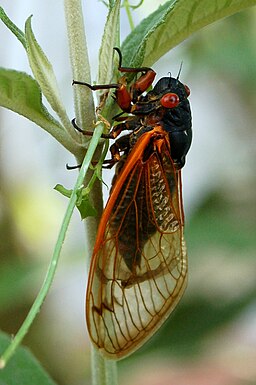 |
| 13-year cicada from Brood XIX. Via Wikimedia Commons. |
Why 13 or 17 years? These prime-numbered periods have puzzled more mathematically-minded biologists for ages, with one suggestion being that a prime-numbered life cycle would minimize the number of predator life cycles that could synchronize with it (because a prime number has no factors but itself). But how did this situation evolve?
A new paper published in PNAS (open access) from a group of Japanese scientists looks at the phylogeny and population genetics of the known species of periodic cicadas. The periodic cicadas fall within the genus Magicicada, within which are species partly defined by the length of their period. M. tredecim for example is a 13-year species, while M. septendecim is a 17-year species. Within each species there are also multiple "broods", representing different cohorts have the same emergence and mating cycles. One brood may encompass multiple species. Siva blogged here about one such brood in 2004, the ominously-named Brood X, which had an unusually large emergence (the "X" is actually just a roman numeral). The different species fall within three species groups, each with both 13- and 17-year species.
Contrary to expectations, the old species, defined by morphology and period, do not correspond to the evolutionary history as uncovered by molecular phylogeny and haplotyping. The three big species groups are still supported, representing two evolutionary splits at about 3.9 and 2.5 million years ago (Mya). The splits within the species groups, however, are relatively recent, mostly less than 0.5 Mya. Furthermore, the splits correspond more to geographical regions than to life cycle period. The split between 13- and 17-year periods have also evolved multiple times. To quote from the paper:
Our results are broadly consistent with the previous idea that an ancestor of all Magicicada diverged into three species allopatrically, and later, the three became sympatric and each species independently diverged into 13- and 17-y cicadas. Surprisingly, however, the divergence of 13- and 17-y cicadas was asynchronous among the species groups and occurred repeatedly even within a species group. This finding is all of the more interesting given that each species group shows similar eastern, middle, and western phylogeographic divisions similar to post-Pleistocene patterns observed in other North American taxa, suggesting that the three Magicicacda groups shared multiple refugia during the last glacial maximum.This is a nice surprise, and as the authors point out, the repeated switching between 13- and 17-year forms suggests that there is a single genetic "switch" involved, because it is unlikely that a complex mechanism could be repeatedly gained and lost in such a manner.
No comments:
Post a Comment